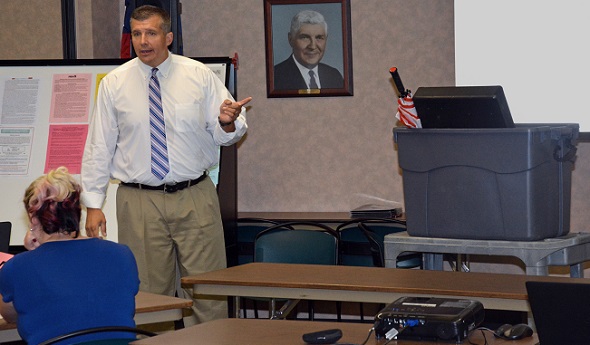
MHSAA's Next Director Welcomes New ADs
July 26, 2018
By Geoff Kimmerly
Second Half editor
EAST LANSING – The first new administrators to take part in the MHSAA's New Athletic Director Orientation Program for 2018-19 on Thursday received what's become an annual greeting by Executive Director John E. "Jack" Roberts – who then handed off for an introduction by Assistant Director Mark Uyl, who will take over for Roberts next month.
The AD orientation program is required for first-year athletic directors and athletic directors at new MHSAA member high schools, and more than 30 were in attendance for this first of three sessions at the MHSAA Office in East Lansing. MHSAA staff will provide this training, primarily on rules and regulations, to an expected 150 new athletic directors this fall, with sessions also Aug. 7 and then Sept. 11 for late hires.
Uyl has served as an Assistant Director at the MHSAA for nearly 15 years and previously was athletic director at Caledonia and Middleville Thornapple-Kellogg high schools. Roberts is retiring in August after serving as Executive Director for 32 years.
PHOTO: MHSAA Assistant Director Mark Uyl points out some of the tools new athletic directors will keep close at hand as they begin their work this school year.

Driving Force that Needs to be Re-Routed
November 30, 2015
The MHSAA's Fall issue of benchmarks examined the transfer regulation, including the reasoning behind recent changes. This is the first of four installments that will appear on Second Half this week.
By John E. “Jack” Roberts
MHSAA Executive Director
During the 2014-15 school year, over the course of 12 meetings, the MHSAA Executive Committee considered 467 requests of member schools to waive Handbook rules. Of those, 300 requests were to waive some aspect of the Transfer Regulation.
So an issue of benchmarks which examines the MHSAA transfer rule is well justified. Perhaps overdue.
Over the years, families have moved about and split apart with increasing frequency. Public policymakers have adopted laws that encourage students to move, and to keep moving, until they find a school more to their liking or they graduate, whichever occurs first.
Meanwhile, the profile of competitive sports has blossomed to the point of becoming overblown, the influence of non-school sports has spread and the delusion of college athletic scholarships has infected the brains of more students and parents. All of which increase the likelihood that students will move as much or more often for athletics as for academics and all other factors combined.
Add to this that the United States, and Michigan in particular, has become the favored landing zone for foreign exchange students, and the result is the need for a transfer rule that is like a great outside linebacker – tough, quick and nimble. We need a rule that is tough, acts fast and can keep changing to keep up with the times.

